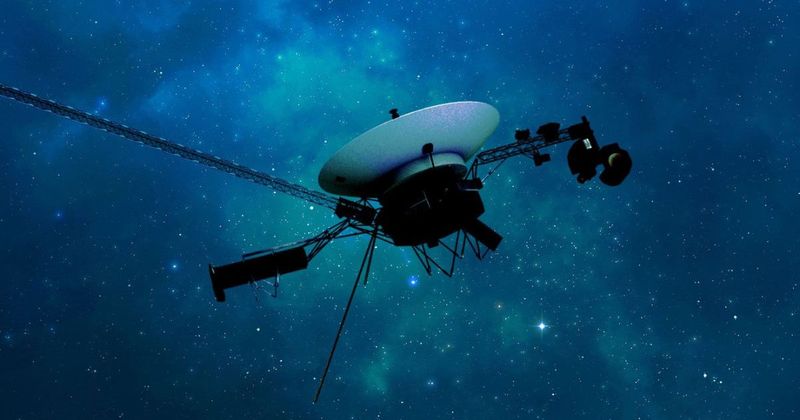Flying over 15 billion miles from Earth, Voyager 1 is the first man-made object to move through interstellar space. Traveling at about 60,000 kilometers per hour relative to the Sun, Voyager 1 is currently the farthest human object. It is a technological marvel that has been zooming around the orbits of the planets for almost fifty years, transmitting useful information. However, in November 2023, the 46-year-old spacecraft got stuck in a loop and started emitting eerie signals in the form of gibberish, unreadable data. After months of encoding and decoding, NASA reported in April 2024 that it had resumed sending readable data for the first time after the error.
We’re back, baby!
Our Voyager 1 spacecraft is conducting normal science operations for the first time since November 2023. All four instruments – which study plasma waves, magnetic fields and particles – return useful scientific data.https://t.co/3FGBOANXGl pic.twitter.com/QqgsCmup7D
— NASA (@NASA) June 14, 2024
“Today was a great day for Voyager 1,” said Linda Spilker, Voyager project scientist at JPL, according to CNN. ‘We have regained contact with the spacecraft. And we look forward to getting scientific data back.” Call it a fluke or the work of engineers, Voyager is now hurtling into interstellar space, far beyond the orbit of Pluto. The problem in question was resolved after a series of trials and errors carried out by engineers after they discovered that the mystery of the malfunction lay in a single chip embedded in the spacecraft’s memory.
When the glitch was first discovered, the engineers could tell from the mission controllers that Voyager was still receiving their commands and functioning normally, but the nonsensical data kept coming. In March 2024, engineers announced that the fault stemmed from one of the three on-board computers, the so-called Flight Data Subsystem (FDS). The FDS is responsible for packaging the scientific and technical data before sending it to Earth in binary code.
Engineers are working to resolve a problem with one of Voyager 1’s three onboard computers, the so-called flight data system (FDS). The spacecraft receives and carries out commands sent from Earth, but no scientific or technical data is sent back to Earth.
— NASA JPL (@NASAJPL) February 6, 2024
While probing the subsystem, the team dug up the source of the failure: a single chip in the FDS memory. They thought the chip was damaged and beyond repair. So they planned to place the affected code elsewhere in FDS memory. But the location had to be large enough to hold this code, and they couldn’t think of such a location.
That’s why they did something out-of-the-box. They divided the code into small segments and stored each segment in a different part of the FDS. After this procedure, they also had to adjust and organize all these code segments so that they could function as one whole. In addition, all references to the previous location of this code in all systems needed to be updated.

While implementing this procedure, the team announced in April 2024 that they had transferred the code to the new location in FDS memory. After this, all they had to do was wait a while. It takes about 22.5 hours for a radio signal to reach Voyager 1, and another 22.5 hours for a signal to return to Earth. Their wait proved fruitful, as on April 20 the mission flight team reported receiving a readable signal from the spacecraft. Their command had worked. The team also promised to fix the other parts of the FDS memory so that the system could work even more efficiently.
Space is difficult. Interstellar space is more difficult. Solving these kinds of problems takes time – because it takes more than 22 hours for a message to travel from Earth to my Twin Voyager 1, and another 22 hours for a response to come back. -V2 https://t.co/aAOqgQEyXm
— NASA Voyager (@NASAVoyager) February 6, 2024
Launched in the summer of 1977, Voyager 1, along with its twin brother Voyager 2, was designed to explore and receive information about Saturn and Jupiter, Saturn’s rings and the moons of both planets. Equipped with Deep Space Network (DSN), a global spacecraft tracking system, the probe was expected to return valuable data, which it did for decades using its highly advanced communications systems. The vessel is equipped with instruments to conduct 10 different experiments.

Instruments include television cameras, infrared and ultraviolet sensors, magnetometers, plasma detectors, and cosmic ray, radio, and charged particle sensors, not to mention the sentiment-filled Gold Record. The intelligent spacecraft is further equipped with a feature called ‘radioisotope thermoelectric generators (RTGs)’, which converts the heat produced by the natural radioactive decay of plutonium into electricity to power the instruments, computers, radio and other systems of to power the spacecraft.

Now that the spacecraft is back in good health, engineers are fascinated by the prospects it offers for deeper space exploration. “We never know for sure what will happen to the Voyagers, but I’m constantly amazed when they continue as normal,” Voyager project manager Suzanne Dodd told CNN. “We’ve had a lot of deviations, and they’re becoming more and more difficult. But we have been lucky to recover from it so far. And the mission continues. And younger engineers are joining the Voyager team and contributing their knowledge to keep the mission going.”
